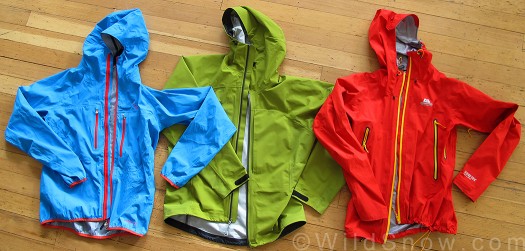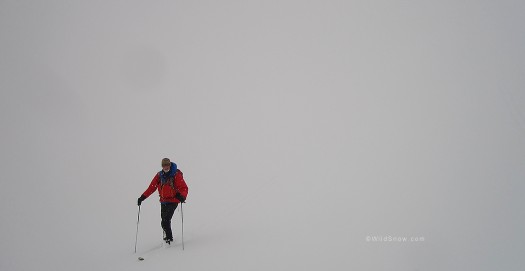
Left to right, Dynafit Patroul GTX, Westcomb Shift Hoody, Mountain Equipment Firefox. Click images to enlarge.
– Dynafit Patroul GTX — Gore-tex Active Shell (13 ounces, 368 grams, size M)
– Mountain Equipment Firefox — Gore-tex Active Shell (11.1 ounces, 316 grams, size L)
– Westcomb Shift Hoody — Polaretec NeoShell (12.2 ounces, 342 grams, size L)
I’ve been playing around with recent fabric offerings that yield water-resistant breathable shells that have soft-shell feel while being beautifully light, quiet, wind-proof and more. Pure serendipity caused these three shells to be in play at the same time here at WildSnow HQ. With one being NeoShell and the others Gore-Tex this isn’t apples to apples, but after using all these shells I realized a comparo would be instructive. Looking at weight vs. features and fabric, we can cover some ground.
First, Gore-Tex Active Shell vs Polartec NeoShell. Lucky for me, I was outside tons of days these past few seasons so I’ve had a chance to test both these fabrics in everything from downpours to cold snaps. First, rain. NeoShell weighs a bit more than Active Shell, but it is most certainly more water resistant. I had my Mountain Equipment Firefox Active Shell jacket on for a one hour hike in quite a rainstorm, and it wet through at my pack straps and places on the shoulders. In similar situation another time, a Westcomb jacket made with NeoShell stayed dry. So if your days might include rain or wet snow by all means consider something that hates water more than Active Shell. On the other hand, many skiers hardly ever encounter such conditions — for us, lightweight Active Shell is almost always all we need for an outer layer.
Yep, for what you get in water resistance, wind proofness and feel, Active Shell is nice stuff. I like. It’s definitely my go-to choice for winter season ski mountaineering. But come spring, unless I’m on a roadside wonder with easy egress I do like the security of something that’ll keep my dry in the rain, so in that case I’ll pack NeoShell or another waterproof-breathable that provides more of a “rain jacket” performance level.
Looking at this whole picture, you have to admit it’s amazing how light Westcomb got the Shift Hoody to since the Neoshell they used appears to be a slightly heavier fabric than the Active Shell of the other jackets. This was done via rather ruthless minimalism — i.e., excellent design. For example, I don’t need bulky pockets under my pack waistbelt. Westcomb? Ditch ’em. Same with Napoleon pockets. Who needs two, how about one? Again, Westcomb comes through. (Though their version of a Napoleon is ridiculously small, making me wonder why it couldn’t have been much bigger and backed with feather weight mesh instead of another layer of jacket fabric?) And pit zips? If you need those look elsewhere to haul the extra weight and pay the extra money for a feature that says “read our thousand words of PR about how well this fabric breathes, but enjoy the pit zips in this jacket anyway.”
While the weights vary a bit, it’s interesting what you pay for by carrying extra ounces — and how some ounces are saved.
In the case of the Mountain Equipment Firefox, lightest of our triad at 11.1 ounces, I was surprised they included pit zips in this ultra breathable full-zip jacket. Pit zips in this jacket are like adding an extra set of wings to a sparrow. On the other hand, I like the high vest pockets, though it would be nice if the zippers were in front of the pockets where you’d have better control of what was inside (thus making these into “Napoleon” pockets). The Firefox Hood fits over a helmet – tightly. Cuffs are basic velcro overlap tab style, which to me is unnecessary on this type of jacket. One has to wonder, if they got rid of the Firefox pit zips, tab cuffs and waist drawstring, could they cut an extra ounce off this jacket? That would be awesome. As it is, we like this minimal stripper. First prize for the cool one-hand-pull hood drawstring snuggers.

Lou on a day when Active Shell is the ticket -- in this case, Mountain Equipment Firefox keeps the down puffy dry underneath.
Next up in the weight department for our triplets is the 12.2 ounce Westcomb Shift FT. What you get for the extra ounce here is impressive. Firstly, yes, Polartec Neoshell which holds up better in rain than Gore Active Shell and breathes about the same (though has a slightly stiffer feel). Beyond that, soft liner fabric at your chin, hood that fits snugly on a helmet (but fits), one Napolean pocket reduces weight. Gripes with this jacket: One has to wonder if the front zipper weather flap couldn’t be smaller and less prone to catching the zipper up near your neck where you can’t see it, and the hood drawstrings seem to take two hands to operate — that’s so 1980s. First prize for making a Neoshell jacket this light.
Third on the rack, Dynafit Patroul GTX comes in at 13 ounces at a size medium. That seems rather heavy and I’m not sure of everything that creates those two or so extra ounces. The collar area is lined with a thin comfy fleece; that accounts for part of the extra mass, and the Patroul does have two Napolean pockets that might be worth some of the weight. The reflective stripe on the back adds a few grams as well. Extra fabric that makes the hood fit a helmet a bit more comfortably also accounts for some of the mass increase. Double zipper pull adds a few grams, but hey, in our view those are important if you ever wear a harness. First prize goes to Patroul for eschewing fancy wrist mechanicals that usually end up under your gloves or bunched up against them, and instead having simple elastic wrists with thumb holes — these _always_ end up smoothly inserted under your glove wristlets.
A couple other things: We reviewed an Arcteryx women’s version of these jackets a while ago. I wanted to do a triplet of jackets that fit me so I didn’t include Lisa’s Arcteryx beta FL in this post, but covered the Arc’ before our last Europe trip. Check it out. Also, good way to go ultralight is to not carry a membrane softshell such as the jackets above (or heavier), but instead carry any one of the many super-minimalist hard shells you can find, such as the Outdoor Research Helium at under 8 ounces. The advantages of the membrane soft shells is they offer a small amount of extra warmth, are said to breathe better, are quiet, and simply feel like more of a “wear it anytime” clothing piece than does the harder type of shell. Perhaps part of the choice would be aesthetics, but if you do use any of these lightweight softshells, you can most certainly reduce your insulation layers a tiny bit — or just depend on it to add a smidgen of warmth. Me, I go both ways. For ultra-light packing I’ll bring my Helium, but I love the feel of these soft shells and tend to tune other layers so my pack ends up about the same weight, a few ounces heavier at the most.
There you go, a fun little comparo to help look at fabric type vs features vs weight. Shopping links below, these jackets will be easier to find come autumn.
Shop for Mountain Equipment clothing.
Shop for Dynafit clothing.
Shop for Westcomb clothing.
WildSnow.com publisher emeritus and founder Lou (Louis Dawson) has a 50+ years career in climbing, backcountry skiing and ski mountaineering. He was the first person in history to ski down all 54 Colorado 14,000-foot peaks, has authored numerous books about about backcountry skiing, and has skied from the summit of Denali in Alaska, North America’s highest mountain.
